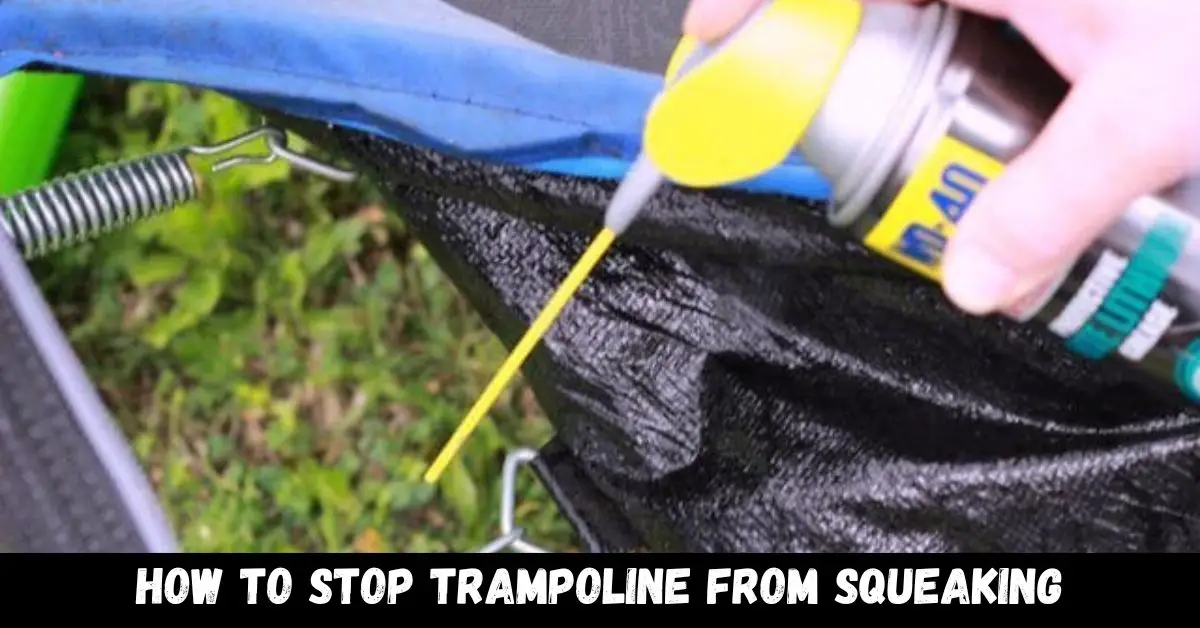If you are worried about how to stop trampoline from squeaking? You can easily fix it and enjoy a quiet bouncing experience. First, inspect the trampoline and clear the area around it. Next, find where the squeaking comes from by closely looking and listening while bouncing.
Once you identify the source, apply lubricant to the springs, frame joints, and metal-to-metal contact points. Let the lubricant spread and penetrate. Check for loose components and tighten them securely with the right tools.
Replace parts with the manufacturer’s instructions if parts are worn or damaged. Adjust the spring tension if needed, ensuring it’s not too loose or tight. Finally, inspect the frame alignment and make any necessary adjustments.
Remember to clean and maintain the trampoline to prevent future squeaking regularly. Following these steps, you’ll have a squeak-free trampoline and enjoy a peaceful bouncing experience.
How to Stop Trampoline From Squeaking: Stop squeaking with these easy steps. Find the source, lubricate, tighten, and maintain for a quiet bouncing experience.
What is the cause of trampoline squeaking?
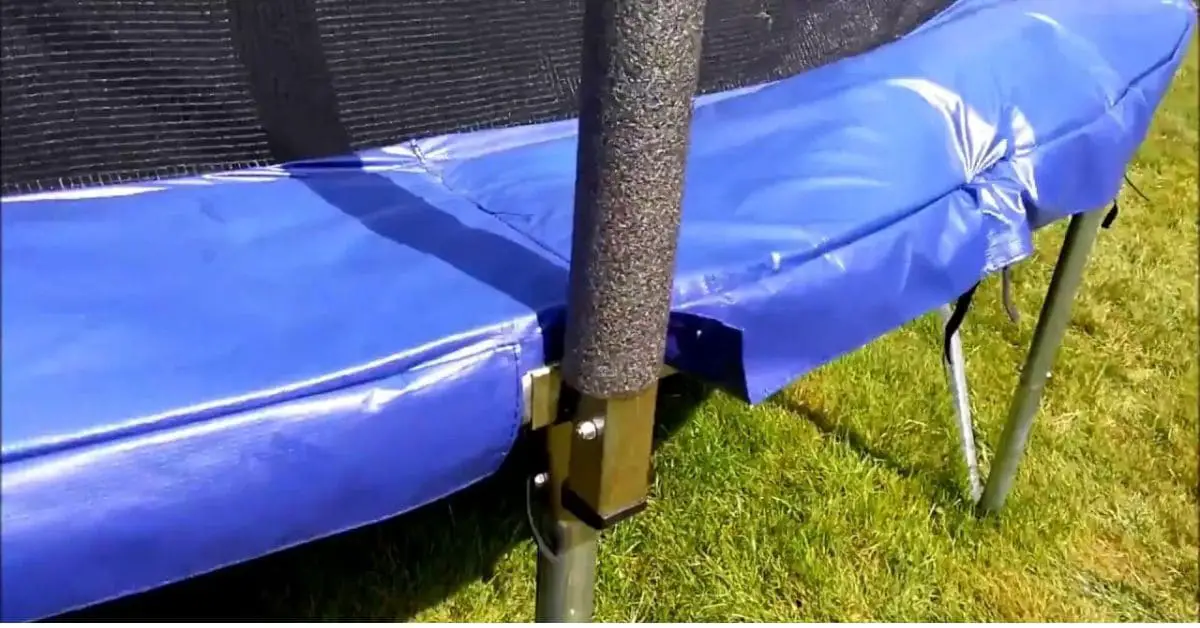
The squeaking noise you hear from your trampoline is mainly caused by friction. When the metal parts of the trampoline’s frame rub against each other, it creates a high-pitched squeal. This is a common issue, especially in older or poorly maintained trampolines.
Lack of lubrication is often the main reason for the squeaking, but there can be other causes too, such as loose screws, damaged springs, bent legs from jumping too hard, or damaged mats.
To fix the squeaking, you need to check specific areas like the spring hooks that connect the mat to the frame, the springs themselves, and the joints on the frame where bolts and screws are located.
Addressing these issues can eliminate the squeaking and enjoy a quieter trampoline.
How to Stop Trampoline From Squeaking?
To stop your trampoline from squeaking, follow these steps:
Using Rust Remover Spray:
To remove rust from your trampoline, follow these steps:
- Get a rust remover spray designed for metal surfaces.
- Clear the area around the trampoline and ensure good ventilation.
- Read and follow the instructions on the rust remover spray.
- Shake the spray bottle and apply it generously to the rusty springs and frame.
- Wait for the recommended time to allow the rust remover to work.
- Gently scrub the rusted areas with a small nylon brush or soft-bristle brush.
- Rinse the trampoline thoroughly with water to remove any residue.
- Dry the trampoline completely using a clean cloth or towel.
- Consider applying a protective coating or paint designed for metal surfaces to prevent future rust.
Regularly maintain and inspect your trampoline to catch rust early and ensure safe and long-lasting use.
Using WD-40 Spray to Lubricate Trampoline Springs:
To maintain the moving metal parts of your trampoline, like the frame joints and springs, WD-40 is an excellent choice. It acts as a lubricant and protects against corrosion. Follow these steps to use WD-40 on your trampoline:
- Ensure the trampoline is stable and set up safely.
- Purchase WD-40 from a hardware store or online.
- Shake the can well to mix the ingredients.
- Spray WD-40 generously on the frame joints, ensuring full coverage.
- Coat the springs evenly with WD-40 to reduce friction and prevent rust.
- Ask a friend or your child to bounce on the trampoline while you apply WD-40. This helps distribute the lubricant to all moving parts.
Regular use of WD-40 on the frame joints and springs will keep them well-lubricated and protected. This will ensure the trampoline operates smoothly and safely for your enjoyment.
Fixing or Replacing Damaged Trampoline Springs:
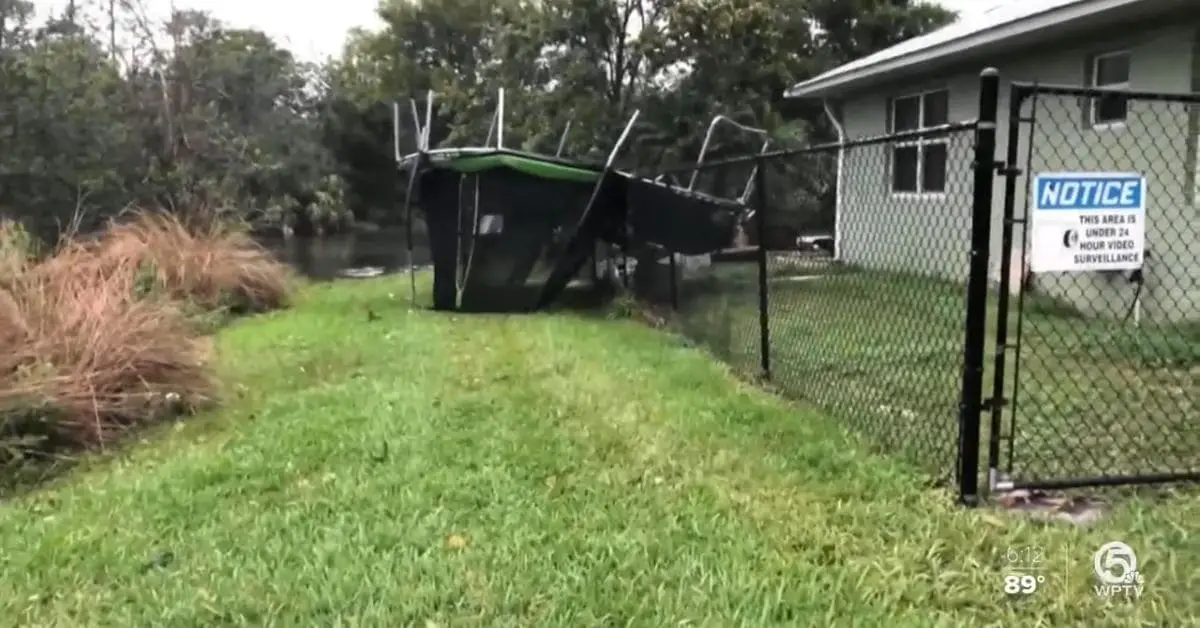
It’s important to know when your springs need to be replaced. If you notice that the springs have significant rust or corrosion, it’s time to replace them. To do this, measure and count the length of your current springs.
Then, visit a local hardware store or an online vendor to purchase replacement springs. Springs are generally easy to find and obtain. Make sure to choose the correct size and type of springs for your trampoline.
By replacing damaged springs, you can ensure your trampoline’s safety and optimal performance while enjoying a fun bouncing experience.
Prefer Bolts Over Screws:
An alternative solution to prevent trampoline squeaking is using bolts instead of screws to connect the various metal parts. Unlike screws, which may loosen over time, bolts provide a more secure connection that minimizes movement and eliminates creaking noises caused by metal shifting against metal.
You must replace the existing screws with appropriately sized bolts and corresponding nuts to implement this solution. It’s important to ensure the bolts are compatible with the trampoline’s frame and components.
Begin by carefully removing the screws from the frame joints and other areas where they are currently installed. Keep track of the removed screws to ensure proper replacement.
Next, select bolts that are the appropriate length and diameter for the trampoline’s frame and joints. Insert the bolts through the corresponding holes and secure them tightly with the nuts. Tighten the nuts sufficiently to ensure a firm and stable connection.
Using bolts instead of screws can achieve a more secure and durable attachment, eliminating the potential for shifting and creaking noises. This helps maintain the stability and integrity of the trampoline, providing a quieter and more enjoyable bouncing experience for users.
Trampoline Mat Cleaning:
Sometimes, the squeaking noises on a trampoline may originate from the mat. To address this issue, regular maintenance and cleaning are essential. Ensuring the trampoline mat is free from excess dirt and debris can help minimize squeaking.
However, it’s crucial to exercise caution and avoid using the trampoline when it is damp. Jumping on a wet mat can intensify the squeaking noise and pose safety hazards due to reduced traction.
By practicing routine maintenance and cleaning, you can keep the trampoline mat in good condition and reduce the likelihood of squeaking. This will contribute to a more enjoyable and quieter trampolining experience for users.
Remember to follow the manufacturer’s cleaning and maintenance guidelines to ensure your trampoline’s longevity and performance.
Trampoline Frame Cleaning:
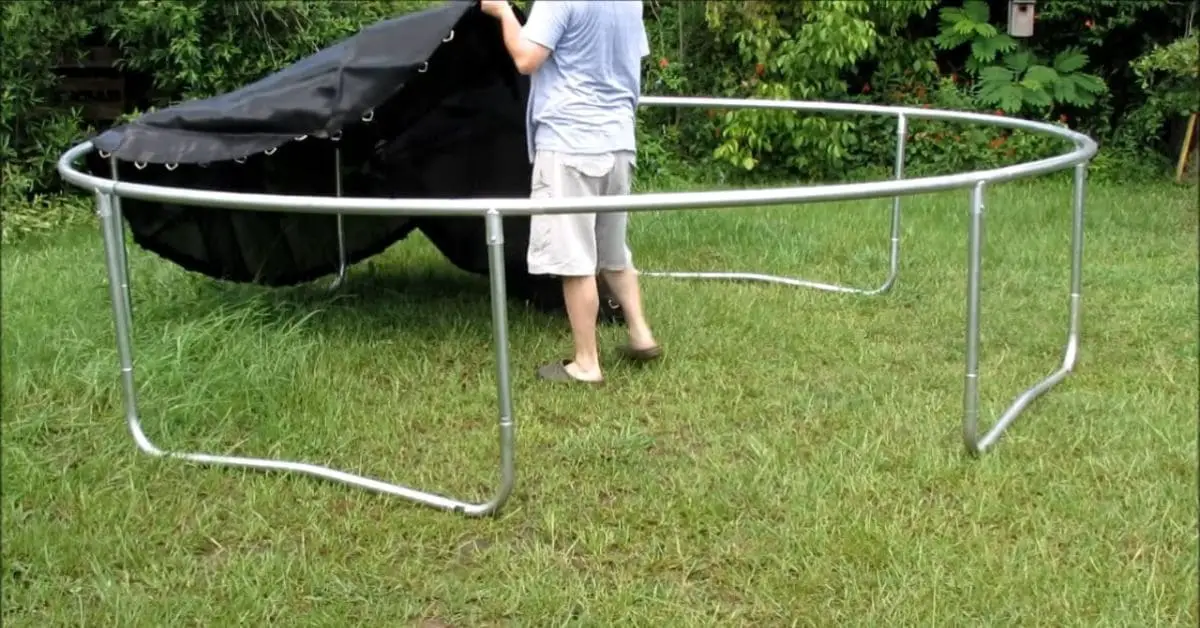
After applying a rust remover to the trampoline frame, it is crucial to avoid leaving the solution on the surface.
Once the cleaning process is complete, thoroughly rinse the frame and springs with water. Use clean towels or clothes to remove excess water to ensure no moisture is retained.
Alternatively, you can let the trampoline dry naturally in the sunlight. By allowing the trampoline to air dry, you can ensure that no residue from the rust remover is left behind.
This not only helps maintain the trampoline’s appearance but also promotes its overall durability and prevents any potential damage caused by prolonged exposure to the cleaning solution.
Properly rinsing and drying the trampoline frame after using a rust remover is essential in its maintenance routine. Following these guidelines, you can preserve the trampoline’s quality and extend its lifespan for long-lasting enjoyment.
Lubricate the Joints:
If you’ve tried all the previous steps and your trampoline is still squeaking, lubricate it with oil or Vaseline. Take a small amount, about the size of a pea, and apply it to the upper side of the eyelet where the spring hooks into the frame.
Use your fingertip to do this. Once applied, continue bouncing on the trampoline for a few minutes. The lubricant will spread and coat the necessary areas, reducing the squeaking noise.
It’s important to note that you should use a small amount and that the lubricant will take a few minutes to fully coat the trampoline. You can further reduce or eliminate any remaining squeaking sounds by lubricating the joints.
Proper Handling of Screws:
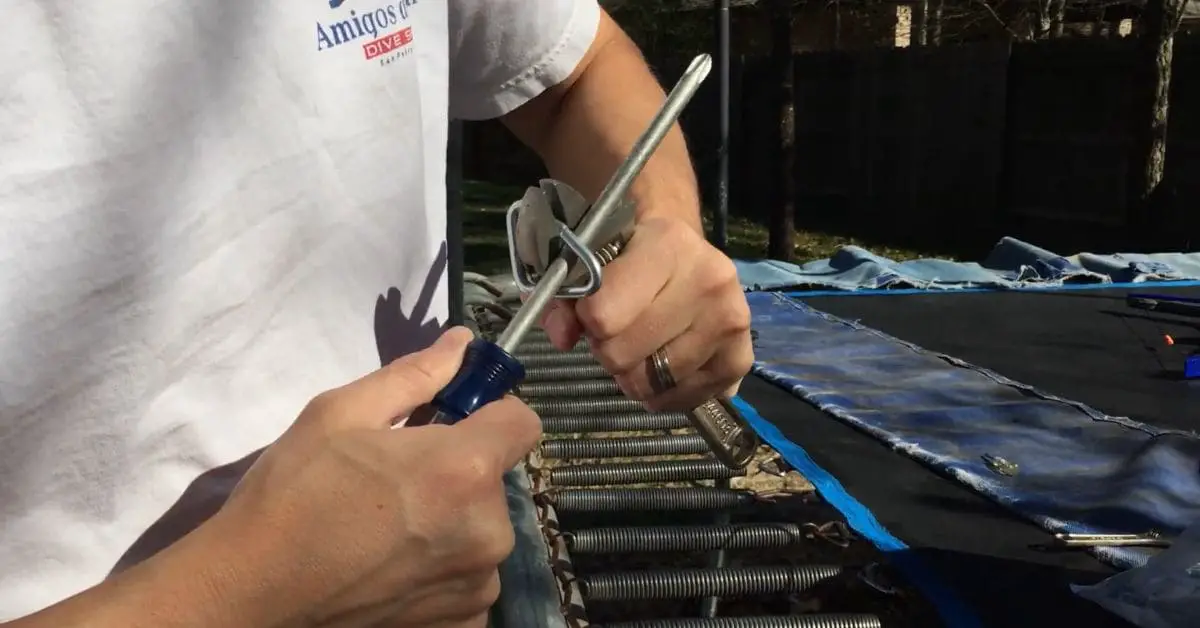
The screws on your trampoline can sometimes cause annoying noise for different reasons.
If they have become loose, the entire trampoline may shake while you bounce. If the screws are rusted, it’s important to remove and clean them.
After cleaning, you can spray them with WD-40 to prevent further rusting and reinstall them. Alternatively, you can purchase new screws if needed. Properly handling and maintaining the screws will help reduce noise and ensure the stability and safety of your trampoline.
Appropriate Trampoline Storage:
Preventing trampoline noise issues involves taking precautions and practicing proper storage. Clear the area around the trampoline and clean it thoroughly to remove any debris. If possible, disassemble the trampoline following the manufacturer’s instructions.
Store it upright to reduce strain on the joints and minimize metal-on-metal contact. If storing outdoors, use a weatherproof cover to protect it from the elements.
By following these steps, you can prevent trampoline noise and ensure your trampoline remains in good condition for years to come.
Top Trampoline Lubricant for Squeak Prevention
You might be wondering why lubrication is needed for trampolines since the springs don’t move. However, there are still areas on the frame where friction occurs, causing squeaks. Luckily, with modern spring designs, you can eliminate squeaks using lubricating sprays and greases.
While WD-40 is a commonly used product that can solve the squeaking problem, it doesn’t last very long, so you’ll need to reapply it regularly.
An alternative option is the InterFlon Fin Super Lubricant. It is more durable and effective than WD-40, providing longer-lasting squeak prevention for your trampoline.
Interflon Fin Super – Effective Clean Lubricant:
- Long-Lasting Lubricant – Provides Extended Lubrication Compared to Regular Products
- Ideal for Bicycles, Fishing Rods, Firearms, Tools, and Moving Parts
- Repels Moisture, Dust, and Dirt for Smooth Performance
- Clear, Odourless, and Does Not Stain
- Leaves a Dry Film, No Sticky Residue
What is the process for applying trampoline grease to the springs?
If you decide to lubricate your trampoline springs, it’s important to note that WD-40 might not provide long-lasting lubrication. Instead, consider using Fin Super lubricant.
To apply the lubricant, first detach the spring from the mat. This will make it easier to apply the lubricant accurately.
Before spraying the lubricant, make sure the spring is clean and dry. Removing any dirt and dust is important, as they can affect the lubricant’s effectiveness.
Once you’ve applied the lubricant, test the trampoline by doing a few jumps. If the squeaking issue persists, identify the specific spring causing the problem and repeat the lubrication process.
By following these steps, you can effectively apply trampoline grease to the springs and address any squeaking issues.
Preventing Trampoline Noise Issues:
Preventing Trampoline Noise Issues to Maintain Good Relations with Neighbors.
Sometimes, when people, especially young children, jump on trampolines, it can get really loud and annoying. The squeaking noise can be particularly bothersome.
To avoid conflicts with your neighbors, you can follow the earlier tips to reduce or eliminate the squeaking noise. It’s also important to ensure your kids don’t jump on the trampoline at night.
Tell them that if everyone is inside the house or the lights are off, it’s not a good time to jump. By considering noise levels and timing, you can maintain good relations with your neighbors and enjoy your trampoline without causing disturbances.
How to Stop Mini Trampoline from Squeaking?
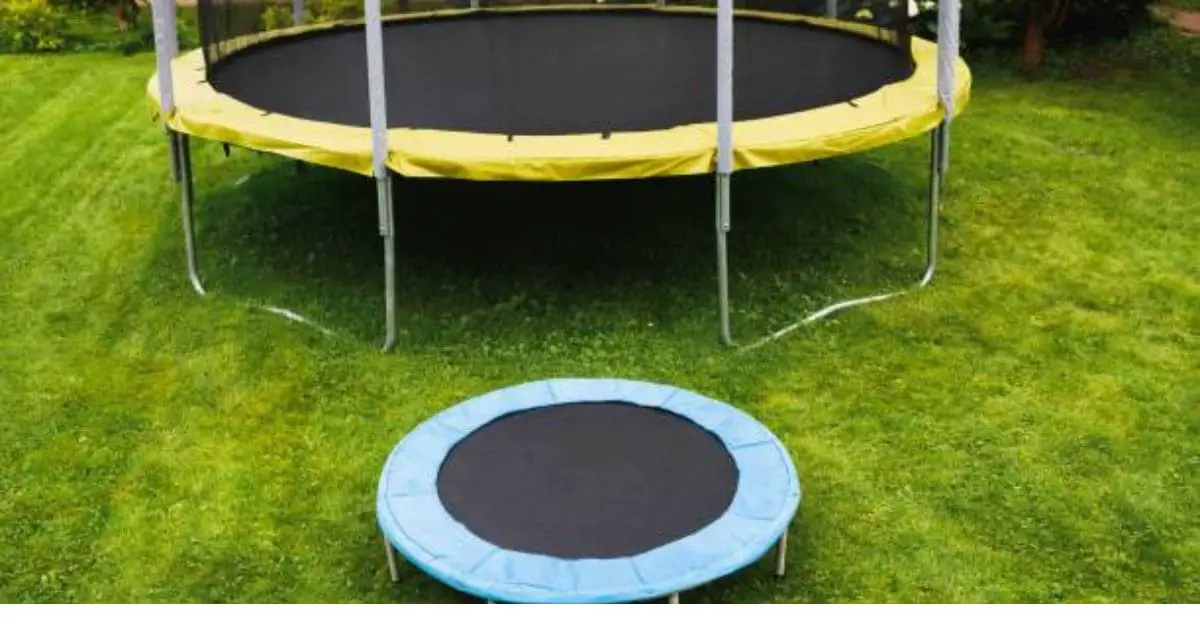
To stop a mini trampoline from squeaking, you can try the following steps:
Check the joints and connections:
Inspect the joints, springs, and frame of the mini trampoline. Ensure that all the connections are secure and tightened properly. If any parts are loose, tighten them with the appropriate tools.
Lubricate the springs and joints:
Apply a lubricant specifically designed for metal surfaces, such as silicone spray or trampoline lubricant, to the springs and joints. Follow the manufacturer’s instructions for application. Lubrication helps reduce friction and can eliminate squeaking sounds.
Clean the trampoline:
Remove any dirt, debris, or dust that may have accumulated on the mini trampoline. Use a soft brush or cloth to gently clean the surface. This can help prevent noise caused by particles rubbing against each other.
Use a trampoline mat cover:
If the squeaking noise comes from the mat, consider using a trampoline mat cover. This cover can provide a protective layer and reduce friction between the mat and the springs, minimizing noise.
Regular maintenance:
Perform regular maintenance on your mini trampoline. This includes checking for any signs of wear or damage and addressing them promptly. Keep the trampoline clean and well-maintained to prevent squeaking and ensure its longevity.
Following these steps, you can address squeaking issues and enjoy a quiet and enjoyable bouncing experience on your mini trampoline.
How to Stop Trampoline Springs Squeaking?
To stop trampoline springs from squeaking, you can follow these steps:
- Inspect the springs: Check the condition of the springs on your trampoline. Look for any signs of rust, wear, or damage. If you notice any damaged or rusty springs, replacing them is best to eliminate the squeaking noise.
- Lubricate the springs: Apply a lubricant specifically designed for metal surfaces, such as silicone spray or trampoline lubricant, to the springs. Spray a generous amount of lubricant on each spring, covering the entire surface. This will help reduce friction between the springs and prevent squeaking.
- Bounce on the trampoline: After applying the lubricant, bounce on the trampoline to distribute the lubricant evenly across the springs. This will ensure the lubricant reaches all the moving parts and helps eliminate any remaining squeaking sounds.
- Regular maintenance: Perform regular maintenance on your trampoline, including inspecting the springs, cleaning the surface, and lubricating the moving parts. This will help prevent future squeaking issues and keep your trampoline in good condition.
Remember to follow the manufacturer’s instructions for any lubricants or maintenance products you use and ensure that the trampoline is safe before bouncing on it.
How to Fix a Squeaky Trampoline?
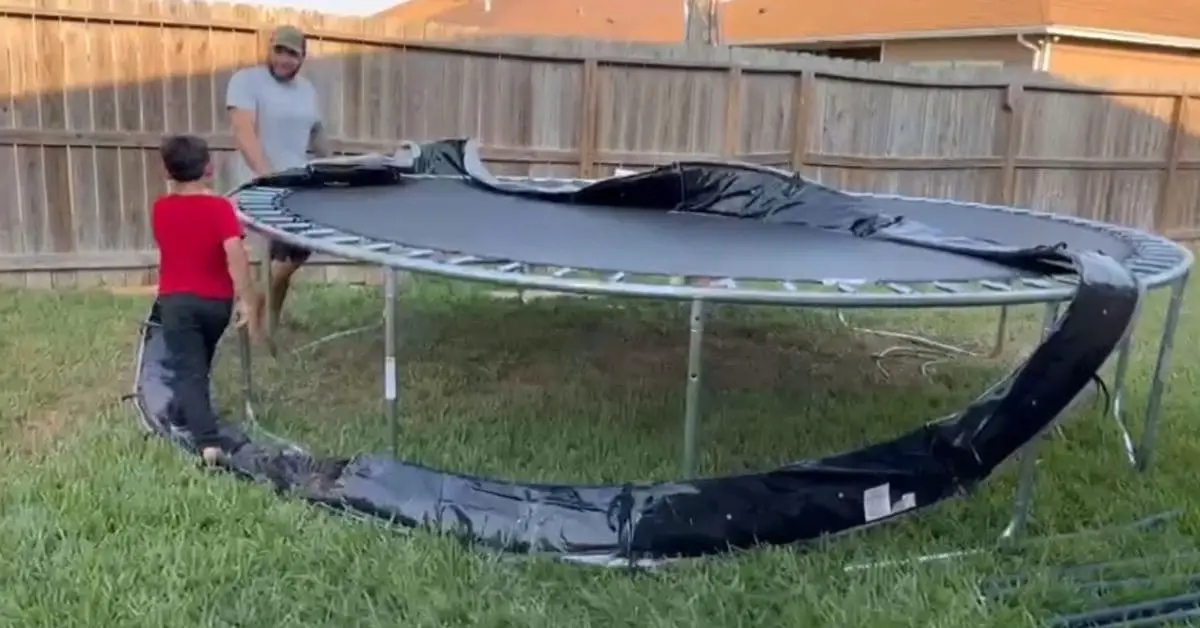
To fix a squeaky trampoline, you can try the following steps:
- Identify the source: Determine the source of the squeaking noise. It could be the springs, frame joints, or other metal components. Listen closely to locate the specific area causing the squeak.
- Inspect for damage: Examine the trampoline for any signs of damage, such as rusty springs, loose bolts, or worn-out parts. If you identify any damaged components, consider replacing them to eliminate the squeaking.
- Lubricate moving parts: Apply a lubricant specifically designed for metal surfaces, such as silicone spray or trampoline lubricant, to the springs, frame joints, and other moving parts. Spray the lubricant generously on the affected areas to reduce friction and eliminate squeaking.
- Tighten loose parts: Check for loose bolts, screws, or nuts on the trampoline. Use appropriate tools to tighten them securely. Loose connections can contribute to squeaking noises, so ensure all parts are properly fastened.
- Test and repeat: After lubricating and tightening, test the trampoline by bouncing it to see if the squeaking has been resolved. If the noise persists, try to pinpoint the exact location of the squeak and repeat the lubrication or tightening process in that area.
- Regular maintenance: Maintain your trampoline regularly by cleaning the surface, inspecting for damage, and lubricating moving parts. This preventive maintenance can help prevent squeaking issues in the future.
If the squeaking problem persists despite your efforts, consulting the trampoline manufacturer or seeking professional assistance for further troubleshooting or repairs may be helpful.
Test and Reassemble
It’s crucial to test and reassemble the trampoline to ensure the squeaking issue is resolved. Start by carefully bouncing on the trampoline to assess whether any squeaks persist.
If you still hear squeaking, it’s essential to reinspect the previously identified areas, such as the springs, frame joints, and mat connections. Repeat the tightening and lubrication steps as needed until the squeaking is completely eliminated.
Once you’ve successfully silenced the squeaks, carefully reassemble any parts you may have disassembled during the process. This comprehensive testing and reassembly step guarantees a squeak-free and safe trampoline experience for users.
Regular Maintenance
Regular maintenance is key to preventing and stopping trampoline squeaking. Here are some steps you can take:
Establish a Maintenance Schedule:
Establishing a regular maintenance schedule for your trampoline is crucial in maintaining its optimal condition. Create a specific timetable, such as monthly or quarterly, to ensure that the necessary maintenance tasks are performed consistently.
These tasks may include cleaning the trampoline mat and frame, inspecting and tightening bolts and screws, lubricating moving parts, and checking for any signs of wear or damage.
By adhering to a regular maintenance schedule, you can address minor issues promptly, prevent potential problems from escalating, and prolong the lifespan of your trampoline.
Additionally, it helps ensure a safe and enjoyable trampolining experience for users of all ages.
Clean the Trampoline Regularly:
Regularly clean the trampoline to prevent dirt, debris, and other contaminants from accumulating. Use a broom or brush to remove loose particles from the mat, springs, and frame.
Additionally, you can use a mild soap solution and a soft cloth to wipe down the surfaces and remove stubborn stains.
Inspect and Address Issues Promptly:
Conduct routine inspections of your trampoline to identify any signs of wear, damage, or loose components. Check the springs, frame, mat, and safety enclosure, paying attention to rust, tears, bent parts, or loose connections.
Address any issues promptly by replacing damaged parts, tightening bolts and screws, or seeking professional assistance.
Lubricate Moving Parts:
Apply a suitable lubricant to the springs and frame joints, such as silicone spray or trampoline-specific lubricant. This helps reduce friction and prevent squeaking sounds. Follow the manufacturer’s instructions for proper application and reapply the lubricant as needed.
Protect from Harsh Weather:
If your trampoline is situated outdoors, it’s important to take precautions to protect it from the elements. One effective measure is to use a weatherproof cover whenever the trampoline is not in use. This cover acts as a shield, safeguarding the trampoline from rain, snow, and excessive sunlight.
By preventing direct exposure to moisture, the cover helps inhibit rust formation on metal components, such as the frame and springs. It also prevents the mat and padding from becoming waterlogged, compromising their durability and leading to mold or mildew growth.
Additionally, the cover helps reduce UV rays’ impact, minimizing fading and deterioration of the trampoline materials.
Regularly applying the weatherproof cover when the trampoline is not being used will significantly extend its lifespan and keep it in optimal condition for safe and enjoyable bouncing experiences.
Educate Users:
Ensure that all users, especially children, understand proper trampoline usage and safety guidelines. Teach them not to jump with hard objects or shoes that could potentially damage the trampoline.
Encourage safe and controlled bouncing to minimize unnecessary strain on the trampoline components.
By following a regular maintenance routine, including cleaning, inspections, lubrication, and prompt issue resolution, you can prolong the lifespan of your trampoline and minimize squeaking problems.
FAQs:
Q1: How can I stop my trampoline from squeaking?
To stop the trampoline squeaking, you can lubricate the springs and frame joints with a silicone-based lubricant or grease. This reduces friction and eliminates the squeaking noise.
Q2: What should I use to lubricate the trampoline?
Use a silicone-based lubricant or a specialized trampoline lubricant designed to reduce friction and eliminate squeaks. Avoid using WD-40 or oil-based lubricants as they may not provide long-lasting lubrication.
Q3: How often should I lubricate my trampoline?
It is recommended to lubricate your trampoline every few months or as needed. Regular lubrication helps maintain smooth and quiet operation.
Q4: Can I use household items like cooking oil to lubricate the trampoline?
Using household items like cooking oil for trampoline lubrication is not recommended. They can attract dirt and debris, causing more harm than good. Stick to silicone-based lubricants specifically designed for trampolines.
Q5: What else can I do to prevent the trampoline from squeaking?
Regular maintenance is key. Keep the trampoline clean, inspect for worn-out or rusted parts, and promptly address them.
Avoid jumping on the trampoline with shoes or heavy objects that can increase wear and tear. Properly store the trampoline to protect it from the elements when not in use.
Q6: Why does my trampoline squeak?
The trampoline may squeak due to friction between the moving parts, such as the springs, frame joints, or mat. Lack of lubrication, rust, worn-out components, or loose connections can contribute to the squeaking noise.
Q7: Why is my trampoline squeaky?
Trampoline squeaking can be caused by friction between springs, frames, or mats due to a lack of lubrication, rust, or worn-out components.
Conclusion:
In conclusion, a squeaky trampoline can be a nuisance, but with the right approach, you can effectively eliminate the noise and enjoy a quiet and enjoyable bouncing experience. Regular maintenance is essential to prevent or address any issues that may cause squeaking.
By developing a maintenance schedule, you can stay on top of trampoline care and ensure its longevity. Cleaning the trampoline regularly helps remove dirt and debris that can contribute to friction and squeaking.
Inspecting the trampoline for worn-out or rusted parts allows you to address them promptly by lubricating or replacing them.
Lubrication is key in reducing friction and eliminating squeaks. Use a silicone-based lubricant or specialized trampoline lubricant on the springs and frame joints to provide smooth movement.
Avoid using household items like cooking oil, as they can attract debris and potentially damage the trampoline.
Additionally, taking precautions such as avoiding jumping on the trampoline with shoes or heavy objects and properly storing it when not in use can minimize squeaking and prolong its lifespan.
By following these steps and maintaining your trampoline regularly, you can ensure a quiet and enjoyable bouncing experience for years.
Remember, safety should always be a priority, so if you encounter any significant issues or concerns, it’s best to consult a professional.
We hope you will be well aware of how to stop the trampoline from squeaking after reading this comprehensive article. If you have any questions, feel free to comment below!

